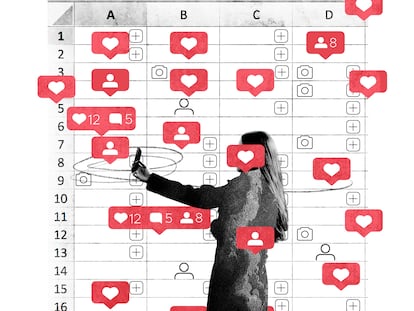Video game designer Adrian Hon: ‘Companies and governments use games to control us’
The expert’s book explains the gamification of society and the often-perverse intentions that accompany the trend

Video game designer Adrian Hon compares medieval-era church indulgences to the gamification of today’s society. Indeed, he asserts that there is a long and strange connection between indulgences in the Middle Ages and retweets. He found out that not everyone could make religious pilgrimages centuries ago; virtual tours were created for those people so they could still be rewarded with indulgences, like real pilgrimages, and go to heaven. That started the 40-year-old Hon thinking.
“I got onto indulgences because I heard someone talking about virtual pilgrimages. I was like, I’ve never heard of this before. What was really interesting was it was such a central part of society. And it wasn’t just that people were buying indulgences because that’s what everyone thinks,” he explains.
“What I wanted to point out is everyone kind of thinks people in the past were just stupid, you know? I mean, people look at [the past] all the time and say, ‘What are they doing? Why are they doing all this?’ Well, there was a reason, they did it because they had this religion, and they thought it was amazing I can imagine someone in the future saying, why did people do this stuff on Twitter? It’s like, well, I think it’s really important to go and get in a few tweets,” he muses.
You've Been Played is out TOMORROW in the UK!
— Adrian Hon (@adrianhon) September 14, 2022
If you're remotely interested in how gamification has become embedded in phones, schools, workplaces, governments, finance, and social media, this is for you.
Get it from your local bookstore or online! https://t.co/XPMppDozKB pic.twitter.com/yHzlyUDDzv
Hon, the English founder of a video game company who is also a neuroscientist, has spent years thinking about the advantages and disadvantages of gamification, that is, using ideas from video games for purposes other than entertainment. He has just published a book summarizing his reflections, You’ve Been Played: How Companies, Governments and Schools Use Games to Control Us All.
Gamification has crept into work at companies such as Amazon, banks, conspiracies, as well as in sports and in creating addictive video games. “They use things like points, medals, levels or missions, and apply them to something that’s not as fun, like exercising or learning languages,” says Hon. Some of these uses make sense and serve as entertainment. But many times, gamification goes beyond those purposes. EL PAÍS spoke by videoconference with Hon, who lives in Edinburgh, Scotland. Below, he discusses his views on the subject.
1. Everything is data now
Some people tell Hon that there’s always been gamification. But Hon disagrees that gamifying has been a constant over time. “The difference now is that we have so much more data and that data is being delivered in real time; it can feed back to us in real time as well. So, I think it is obviously very different when you can get a notification on your phone…saying, hey, we just saw you did this five seconds ago and we’re going to tell you to do something else. That’s different than gamification in the past.” Of course, we also currently have more screens to play with.
2. Is internet scorekeeping deliberate?
The internet is a huge game. All social media and pages offer some kind of ranking: followers, likes, views, visits – they all earn users online “points.”
“I think we can already see how [keeping score online] is changing behavior,” says Hon. “Gamified systems on social media are changing how and what people choose to post. It changes what I choose to post because I’m like, oh, ‘I got this tweet. I should use lowercase letters because that makes it better.’ People like me tweet it more and you just start changing your behavior based on the [feedback]… We have only had this for, like 15 or 20 years. As it becomes more widespread and as we get augmented reality and virtual reality, then it will change our behavior even more,” he adds.
But were these rating systems developed intentionally? After all, one of the creators of the “like” button is dissatisfied with its results. Hon believes that keeping score online was inevitable but not deliberate: “I [don’t] really think anyone does this on purpose. Gamification in video games, on social media, it’s just people seeing what works. People saw that Foursquare became popular and they said what was different before Foursquare?Gamification. We’ll just do that then,” he says. For example, Foursquare allowed users to rank the venues they visited. Those who went most frequently to a place could become “mayors” of the locale. In addition to that “honor,” they could receive a gift from that location.
“Games are fun and build up to fun things,” Hon adds to his explanation of the initial success of online ratings. “I think it’s kind of a free-market capitalism and people just copying each other. It’s a good thing to make your service into a game because people like that,” he observes.
3. Everything is rated
Such scores affect how we behave on social media to get attention. That may be a problem in itself. But scorekeeping creates additional issues. Hon cites a 1989 study that highlights the rise of perfectionism among young people, which he believes fuels gamification. Society as a whole is organized based on ranking and achievement criteria, giving rise to increasing perfectionism. “It’s pretty new that people care about fitness like this. It’s probably the last 50 years where people have an Apple Watch. People know what the heartbeat variability is. The goal is to try and optimize yourself.”
Ranking extends beyond work and physical activity to all facets of life: “If you just look unhealthier or haven’t read as many of the good books, then you’re going to go down the leaderboard,” he explains.
The problem is that not everything can be ranked, because not everything can be quantified. A good example is TripAdvisor and hotel ratings: 4.9 is better than 4.6, but are review criteria comparable? “You can only gamify something at scale if you have data and the data needs to be structured,” he says.
4. Why are streaks desirable?
Streaks are an example of this classification, and they often go to absurd extremes: how many days in a row can you string together a random number of unimportant successes (steps, contributions, comments)? Despite the fact that such achievements don’t mean anything, they nonetheless give people a small sense of satisfaction.
Hon’s company’s most successful game is Zombies, Run!, an audio-based game to make you run a little faster. Hon believes that the major trap of gamification is using generic game gimmicks for any purpose and not adapting them to specific needs.
Streaks are one of those gimmicks; people’s minds push them to keep streaks going at any cost. Take, for instance, Apple Watch’s steps or Fitbits. In the book, Hon cites an example from GitHub, where programmers who cooperated or responded to something every day kept their streaks intact. But Hon says that approach is counterproductive: “I think streaks are really the most powerful and simple and worst forms of gamification. I think it’s bad that they’re actually seen as a good thing to do. Like, why is it a good thing for someone to go and check in [on GitHub]? We shouldn’t even be tracking that.”
He continues: “I think if someone’s running 50 days in a row, that’s probably a bad thing to do. But we [at Zombies, Run!] deliberately don’t reward that. Sometimes I work 110 days in a row, and I think, ‘wow, I’m really good. ‘And I feel exhausted. But I don’t get a medal from Apple that says, ‘well done, you didn’t come today.’ I don’t think it should matter.”
5. Do we really know that they’re playing with us?
Hon recently discovered a video on TikTok posted by an Amazon employee in the United States. In the clip, the worker discussed a game called Tamazilla that encourages employees to work faster by “taking care” of their virtual pets. Do they know that Amazon is playing with their minds?
@leonar.npc Replying to @femceltwilightsparkle Since yall went crazy on the first post here’s a look at some of my favorite Amazon pets! #amazon #amazonfinds #amazonemployee #amazonpicker #amazonfullfillmentcenter #pets
♬ original sound - Justin wyss
“I think some people realize immediately, but I think it just takes time for people to understand what’s happening to them, because it’s so weird and different and new,” says Hon. “In a TikTok video someone recorded this game where they collect virtual pets on Amazon. Some of the comments were like, ‘wow, this actually is really fun. Now, I want to work at Amazon and package boxes because I get to play a game like this.’ But there’s also a comment that says: ‘Hey, guys, it’s not as fun as you think. You can’t clear them. It’s just to make you work fast and with no reward,’” Hon explains.
Hon observes that “what’s really interesting about this whole interaction is that the person posting the videos is saying, ‘hey, this is what I do while working at Amazon and I feel bad. I will have to leave my pets behind. I also know that I’m being manipulated now.’ I don’t know how long it took this person to realize they’re being manipulated.But I think that it’s really interesting that Amazon would probably go and say: ‘Oh, we think that people like these games because we can see people playing them a lot. And people say in surveys that they like them’ and it’s like, yeah, but that’s because you give them no choice.”
Isn’t that better than working and being bored? Hon says they have no choice in the matter. “There’s nothing else they can do in the workplace besides play games.” Moreover, Hon notes that it’s also a mediocre solution to another problem at work: “If you have a workplace where employees are not working hard and they always seem miserable, what we should do is find a workplace that will make them happier, and they’ll also work harder. I think that managers and owners are looking for a really easy way to change nothing at all about the job, or even just cut people’s pay [and they turn to gamification],” adds Hon.
6. Conspiracy theories are also a game
Conspiracy theories are often prefaced by the phrase, “I have done my own research.” But there’s a catch. Perhaps the best-known case is QAnon in the United States. An anonymous deep state character, QAnon has been giving ambiguous clues about obscure events for years, but they never come to pass. Then there’s always some detail that needs to be reinterpreted. That required sleuthing serves to maintain people’s interest.
“I think if you read the messages by QAnon, whoever they are, you know, they’re obviously invested in this kind of written evidence. You know, they could make puzzles or mysteries... But they’re really vague, partly because they don’t want to be disproven. They can say: ‘Oh, on the fourth of this month, the moon [will do such and such]. And that can mean anything, right? There is something kind of gaming about that. But, when I talk about the gamification, it’s not so much the messages. It’s more the way in which people just get really excited by it. And it’s a very different kind of game than what people are used to thinking about.”
QAnon’s messages give the sensation of solving a puzzle, searching for details that fit, even if they just exist inside a person’s head. “It’s not a game, but it does feel exciting, and it’s even more exciting when you get to talk [other] people and then they’re giving you the clues as well. I think that social networks are encouraging its growth. And I would argue that the scientific method does not encourage people to get in a fight,” says Hon.
7. Marie Kondo and the next stage of gamification
In his book, Hon uses the example of Marie Kondo. You can watch her series, but when you turn off the TV, she doesn’t chase you around the house to make you tidy up. Unlike what has already happened with exercise, work and some conspiracies, the show doesn’t gamify decluttering your closet. But that’s likely to change soon. With augmented reality glasses, Marie Kondo’s video game will be able to bring gamification to private spaces.
In his book, Hon gives the example of mopping the floor. While it is not currently possible to gamify that chore, with augmented reality glasses it will be. Maybe that will be a good thing: with the glasses, we will see cockroaches to kill with the mop or dirty corners to rid of digital dirt. That will encourage mopping. When used correctly, the Apple Watch can also encourage its users to move more; after a few weeks, perhaps they will feel better.
The problem is how games are created. They can be helpful, but that’s not always the case. The same will be true of the augmented reality glasses of the future: “It would be great to make a game that encourages people to pick up trash in the neighborhood [when using] the glasses. I just think that a lot of horrible things will also be gamified,” says Hon.
Sign up for our weekly newsletter to get more English-language news coverage from EL PAÍS USA Edition
Tu suscripción se está usando en otro dispositivo
¿Quieres añadir otro usuario a tu suscripción?
Si continúas leyendo en este dispositivo, no se podrá leer en el otro.
FlechaTu suscripción se está usando en otro dispositivo y solo puedes acceder a EL PAÍS desde un dispositivo a la vez.
Si quieres compartir tu cuenta, cambia tu suscripción a la modalidad Premium, así podrás añadir otro usuario. Cada uno accederá con su propia cuenta de email, lo que os permitirá personalizar vuestra experiencia en EL PAÍS.
¿Tienes una suscripción de empresa? Accede aquí para contratar más cuentas.
En el caso de no saber quién está usando tu cuenta, te recomendamos cambiar tu contraseña aquí.
Si decides continuar compartiendo tu cuenta, este mensaje se mostrará en tu dispositivo y en el de la otra persona que está usando tu cuenta de forma indefinida, afectando a tu experiencia de lectura. Puedes consultar aquí los términos y condiciones de la suscripción digital.
More information
Últimas noticias
The Bolsonaro surname: An advantage or liability in Brazil’s 2026 presidential elections?
Raúl Rocha, from jet-setting with Miss Universe to arms trafficking and fuel theft
80,000 barrels of Mexican oil sent to Cuba: Havana drawn into the US–Mexico clash
Human rights activists, opposition members, and a minor: Maduro’s other political prisoners
Most viewed
- Reinhard Genzel, Nobel laureate in physics: ‘One-minute videos will never give you the truth’
- Pablo Escobar’s hippos: A serious environmental problem, 40 years on
- Charles Dubouloz, mountaineering star, retires at 36 with a farewell tour inspired by Walter Bonatti
- Why we lost the habit of sleeping in two segments and how that changed our sense of time
- The fall of a prolific science journal exposes the billion-dollar profits of scientific publishing











































